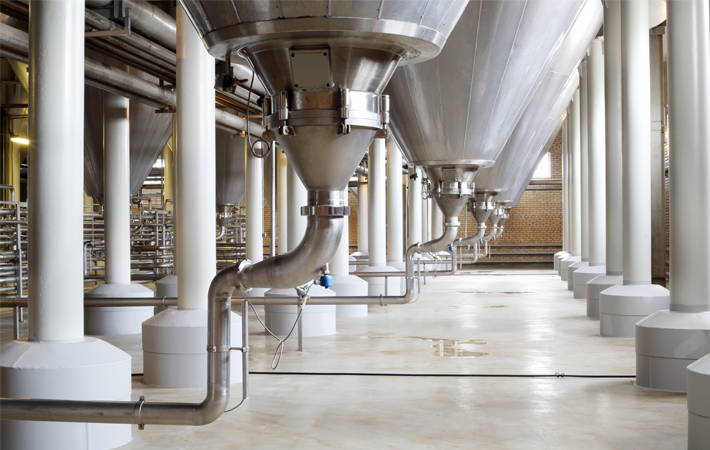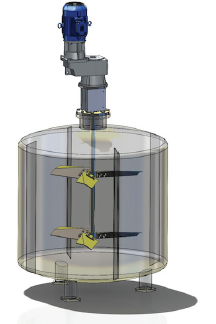
Just as the geometry of a tank's sides can affect mixing (square vs. cylindrical), the head (which is the name for the bottom of the tank, for whatever reason) can have just as much effect.
There are four basic geometries of mixing tank head design: flat, dished, sloped, and cone. I talked to Sean Donkin of Cleveland Mixer to get the scoop on the pros and cons of each design.
Flat bottom tanks are very common and does not affect mixing in a negative way.
Advantages
Flat bottom tanks generally have lower manufacturing costs because they're the easiest to make. This type of bottom has neutral geometry for solids suspension and overall fluid motion. The overall mixer shaft length can also be reduced, reducing the cost of the mixer.
Disadvantages
As you might expect, a flat bottom tank doesn't drain particularly well, especially when solids and high viscosity fluids are involved.
 Dished heads are rounded and often used in pressurized tanks. There are a number of different geometries within this category.
Dished heads are rounded and often used in pressurized tanks. There are a number of different geometries within this category.
Advantages
Tanks with dished heads have increased overall rigidity. The rounded bottom assists in the drainage of the tank, and offers dramatically better solids suspension performance than a cone bottom (with the exception of the 2:1 elliptical heads).
Dished or torispherical bottoms, in general, offer a good trade off of strength, draining performance, and axial flow patterns.
Disadvantages
With this geometry, the overall tank height is increased, meaning a longer shaft will need to be employed. Shaft length will further be increased when using 2:1 elliptical heads, as the bottom impeller often needs to be placed withing the area of the bottom dish. This increases overall mixer cost.
Additionally, for 2:1 elliptical heads, the depth of the head presents additional solids suspension challenges that might require a small 'kicker or tickler' impeller.
Sloped bottom tanks have, as the name suggests, a sloped bottom. In this design, accessing the bottom of the tank is easier, ideal for tanks where the drain is on the bottom.
Advantages
Asloped bottom tank offers very good draining performance without the same magnitude tradeoffs of the cone bottom tank.
Disadvantages
With solids suspension applications, as the depth of the slop increases, so does the degree of difficulty to achieve good solids suspension performance.
Additionally, if a steady bearing supported shaft is used, there needs to be close collaboration between the tank manufacturer, mixing manufacturer and the on-site installers to ensure that the steady bearing housing is properly aligned with the mixer mounting structure.
Cone bottom tanks used in nearly every industry, especially where getting every last drop from the tank is important.
Advantages
This type of tank has excellent geometry for draining, especially with high solids content slurries.
Disadvantages
Cone bottoms and solids suspension performance do not mix!! This geometry promotes fluid 'stall' and increases the potential for stratification, temperature gradients, and radial flow.
Cone bottoms also require the use of a relatively longer impeller shaft, causing higher relative cost.
Never specify a cone bottom tank if solids suspension is important, especially in solids concentrations above 5%.
If you need a new tank for your application, be sure you get your mixer application engineer in on the process early. They can ensure the mixer and tank will work in concert to deliver the best mix to achieve your process goals.
Need help selecting a tank and/or mixer? Ask us about it! We gladly provide technical assistance to businesses and municipalities in Wisconsin and upper Michigan.
These Stories on Mixing
Headquarters and Service Center
Located outside Green Bay, WI
707 Ford Street
Kimberly, WI 54136
920-733-4425
OptiFlow Design and Build Center
1002 Truman Street
Kimberly, WI 54136
920-733-4425
Burnsville Service Center
12265 Nicollet Avenue
Burnsville, MN 55337
952-444-1949
Grand Rapids Service Center
26489 Industrial Blvd
Cohasset, MN 55721
952-444-1949
© Copyright 2024. Crane Engineering. All Rights Reserved. Privacy Policy.